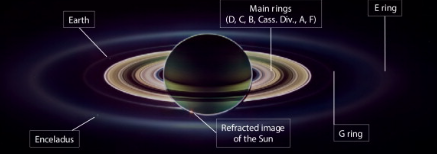Rings of Saturn: A Spectacular Wonder in Our Solar System
Introduction
The solar system is a fascinating realm filled with celestial wonders, and one of its most captivating features is the majestic ring system of Saturn. Known for its beauty and mystery, these rings have fascinated astronomers and space enthusiasts for centuries. In this blog post, we will delve into the intricacies of Saturn’s ring system, Rings of Saturn’s formation, composition, and the role of NASA in unraveling its secrets.

The Discovery of Saturn’s Rings
The discovery of Saturn’s rings dates back to the early 17th century when Galileo Galilei observed the planet through a telescope. However, it was not until 1655 when Dutch astronomer Christiaan Huygens provided a more detailed description of the rings, correctly identifying them as a disc surrounding Saturn. Since then, astronomers have continued to study and marvel at the complexity and beauty of these rings.
Composition and Structure of Saturn’s Rings
Saturn’s ring system is composed of countless particles, ranging in size from tiny dust grains to large chunks of ice and rock. These particles orbit Saturn in a flat plane, forming concentric rings around the planet. The rings are primarily composed of water ice, with traces of other materials such as rock, dust, and organic compounds. The exact origin of the rings is still a subject of scientific inquiry, with several theories proposed, including the breakup of a moon or the remnants of a destroyed moon.
NASA’s Exploration of Saturn and its Rings
NASA has played a pivotal role in unraveling the mysteries of Saturn’s rings through various missions and spacecraft. The first close-up images of the rings were captured by the Pioneer 11 spacecraft in 1979. However, it was the Voyager missions in the early 1980s that provided stunning images and detailed information about the ring system. Voyager 1 and 2 revealed intricate ring structures, gaps, and divisions within the rings, as well as the presence of shepherd moons that shape and maintain the rings’ structure.
Continuing the exploration, NASA’s Cassini spacecraft embarked on a 13-year-long mission to study Saturn and its rings. Launched in 1997, Cassini arrived at Saturn in 2004 and provided unprecedented insights into the planet’s ring system. Cassini’s observations revealed the dynamic nature of the rings, including the presence of waves, spokes, and propellers caused by gravitational interactions with Saturn’s moons.
In addition to capturing stunning images, Cassini’s instruments analyzed the composition of the ring particles, providing valuable data about their origin and evolution. The spacecraft also investigated the moons of Saturn, some of which are believed to have a significant influence on the structure and dynamics of the ring system.
Future Exploration and Discoveries
NASA continues to explore Saturn and its rings through ongoing missions and future endeavors. One such mission is the Dragonfly, a rotorcraft lander set to launch in the mid-2020s. Dragonfly will explore Saturn’s largest moon, Titan, which shares some similarities with early Earth. By studying Titan’s surface and atmosphere, scientists hope to gain insights into the conditions that led to the development of life on our planet.
Moreover, the James Webb Space Telescope (JWST), scheduled for launch in 2021, will enable astronomers to observe Saturn and its rings with unprecedented clarity. With its advanced instruments and capabilities, the JWST will contribute to our understanding of the ring system’s composition, dynamics, and interactions with Saturn’s moons.
Conclusion
Saturn’s ring system stands as one of the most captivating wonders in our solar system. Its beauty and complexity have intrigued humanity for centuries. Through the efforts of NASA and other space agencies, we have gained invaluable knowledge about the composition, structure, and dynamics of these rings. However, many questions remain unanswered, and future missions and discoveries promise to unlock further insights into their origin and evolution. As we continue to explore the mysteries of Saturn and its rings, we are constantly reminded of the awe-inspiring wonders that our solar system holds.
